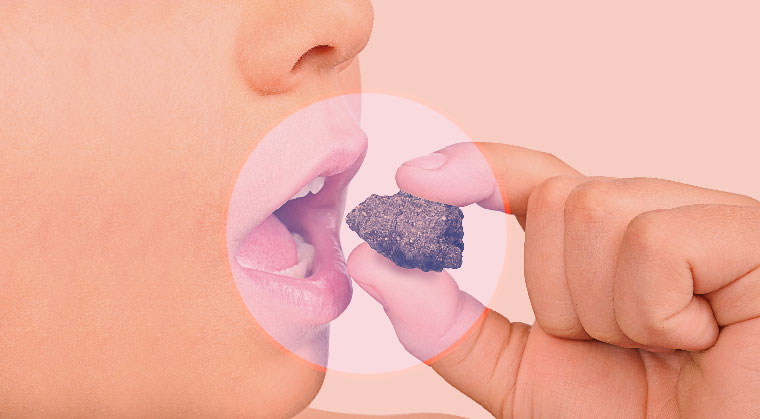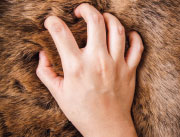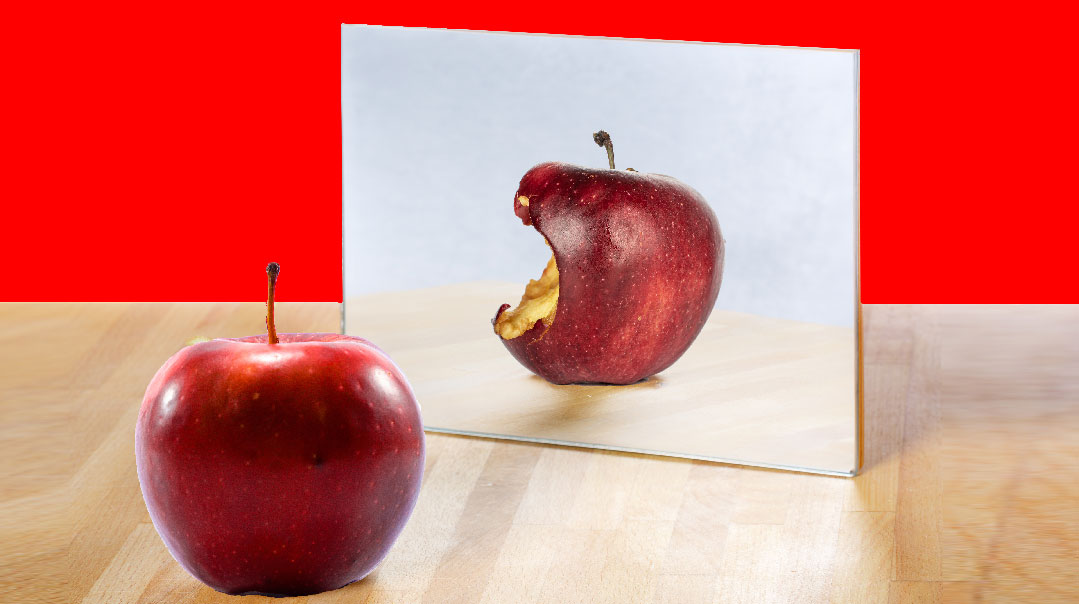From Hand to Mouth

Why does she do that? What makes her eat something as horrible as sand?

Photo: Shutterstock
Something is off about Shaindy. Her peculiar symptoms are alienating her friends and irritating her mother. Once she’s finally diagnosed with sensory processing disorder the real work begins — and change becomes possible.
You know how crawling babies “vacuum” floors exploring the world putting everything that fits directly into their mouths? My daughter is like that. Only she’s not crawling — she’s been doing this for years.
When Shaindy is three her playgroup teacher alerts me to this worrying phenomenon after finding a safety pin in Shaindy’s mouth.
“Oh?” I’m not a panicky mother.
“Toys are one thing; safety pins are another” the morah explains. “They’re really dangerous. Perhaps Shaindy has a sensory issue.”
Sensory huh? Isn’t that when kids dislike textures and things like that? I’m not concerned but I don’t want to be neglectful. I call my sister whose son struggles with sensory issues.
“What can you tell me about sensory issues? Shaindy’s teacher told me that she keeps putting things in her mouth.”
“How is that related to sensory issues?”
“I can’t figure it out either. What does ‘sensory issues’ mean anyway?”
“As far as I know sensory issues are about extra sensitivity to specific textures. Yitzi has clothes that he doesn’t like wearing and he complains about tags being scratchy and elastic belts being too tight. And on Shabbos he gets all nervous if his kugel comes in contact with chicken—”

“At our Shabbos seudah Shaindy can’t sit still. As soon as she comes in for Kiddush she grabs everyone’s cups and cutlery… My husband says I should stop setting the table.”
“I give my kids a stack of plastic cups to play with at the Shabbos table” says my sister. “They’re not in prison! Going back to Yitzi there’s a lot more but I really don’t see any connection between putting things into the mouth and his issues.”
My concerns are laid to rest yet toys and small household items continue appearing in Shaindy’s mouth. I remind her several times each day to empty her mouth. Still I’m not worried. Kids will be kids — and they’re entitled to their shenanigans. She’ll outgrow this. Eventually.
One afternoon when Shaindy is five, I leave her in the yard for a few minutes to check on supper. (Our kid-friendly dead end, with a plethora of mothers and kids outside, is safe enough for me to feel okay doing that.) Uncovering the first pot, I hear the frantic pounding of what sounds like dozens of little fists on my door.
“Shaindy is eating sand,” several high-pitched voices yell. (See, it’s really safe; the kids all look out for each other).
Though their hysterics seem overdone, I can tell that the neighborhood kids look askance at eating sand. And I don’t want Shaindy stigmatizing herself.
“Thanks for telling me about it. I’ll take care of it.”
Following the kids out, I stand off to the side, watching my daughter. Shaindy closes her hand around a fistful of sand, allowing it to run through her fingers. After several times, she licks her fingers clean.
Eeew! I continue watching. Shaindy fills a small shovel with sand and deposits the load on a toy dump truck. Sticking her thumb and pointer into the small load upon the tractor, Shaindy grasps a few grains of sand between her fingers. Then, she slowly brings it to her mouth.
Why? Why, why, why? Why does she do that? What makes her eat something as horrible as sand?
Whereas others are disgusted, I’m frustrated. Haven’t I told her — a 100 or 1,000 times — what does and doesn’t belong in her mouth?
On another occasion, Shaindy swallows a battery. “How did she do that?” the incredulous doctor on call asks.
When Shaindy is in first grade, her teachers report that she is tearing papers and chewing on them.
I’m honest when I tell them that I don’t know how to break this terrible habit. Sharing what I do — namely, removing the offensive item/s from her mouth — I give them complete autonomy to deal with it as they see fit.
Then comes the call from the principal. “I know Shaindy’s teachers spoke to you about her habit of putting things into her mouth. But now she started licking glue.”
“Well, we checked out the anemia possibility when she was younger, so it probably isn’t that. It might just be a very bad habit.”
“My concern is twofold,” says the principal. “Firstly, she’s beginning to set herself apart. Kids are pointing her out as ‘the kid who eats glue.’”
This worries me. Shaindy is painfully shy — this will not help her make friends. Or, maybe…
“Perhaps it’s a call for attention?”
“I’m not going to rule that out, but I don’t think so. I think there’s a deeper issue at play.
“An additional concern is that glue may have some addictive quality. Why don’t you check in with your pediatrician, and we’ll do a motivational behavior chart in school?”
Within a week, her teachers report improvement. When I try this at home, however, it is a grand failure. Maybe it’s too much! She can’t break the habit in school and at home all at once! Let’s do this slowly. Besides, I’m sure she’ll outgrow it; why expend so much effort for something time will take care of? Let kids be kids…
When summer comes around, I notice that when Shaindy is occupied around the clock, she forgets to put stuff into her mouth. Too much downtime leads her to find non-food items to chew. This reinforces the belief that it’s just a habit; I think she does it to relieve boredom.
Since I know Shaindy loves stress balls, I make a deal with her. I’m buying her a new one, and she agrees to squeeze it every time she’s tempted to put a non-food item into her mouth.
She’s excited. I’m skeptical. My hunch is right on target; her stress ball is covered with teeth marks when it’s all of a week old.
Mid-summer the principal calls again. “How is Shaindy’s ‘taking into the mouth’ issue?”
I hem and haw. It’s been the norm for so long, the issue barely registers on my mind.
“We’re having an educational and behavioral consultant in school tomorrow, and I have one slot available for you to discuss Shaindy’s issues with her.”
How can she help? What’s there to discuss? Eventually she’ll outgrow it. And besides, I’m not interested in taking off from work for something I really don’t believe is an issue.
“She’s sat in on numerous classes, in schools all over. Maybe she’ll be able to shed some light.”
I don’t want to be the difficult parent who doesn’t cooperate, so I contain my sigh and go down the next morning.
The consultant tells me that she’s noticed Shaindy’s classroom behavior while on a routine classroom observation, and she’s never seen anything like it. “Shaindy removed non-food items from the trash can,” she says. “Her classmates notice her doing strange stuff, and it’s really setting her apart.”
We discuss several theories, including a sense of insecurity and need for attention.
“I think we should first rule out what can definitely be ruled out,” she says. “Check in with your pediatrician to rule out the anemia concern.”
I thank her and get ready to go.
“You know what else it can be?” she says, almost as an afterthought. “It may be a sensory issue.” She scribbles the names of two occupational therapists (OTs) on a sheet of paper. “I don’t think it is, but you may want to rule it out as well.”
As if I’ve got nothing better to do than run around town, ruling out possibilities for something a kid will soon outgrow!
The following Sunday, we visit a nearby farmer’s market and petting zoo. We pick up some veggies for the kids who will be brave enough to feed the animals, and then head into the sunshine for some quality time with the best of farm life.
Following a dirt path to the goats’ pen, a rustle of brown feathers scurries by.
Shaindy lunges for the escaping turkey.
Ugh! I can’t believe she’s touching that turkey. Though we live in the suburbs, we are city people, and generally stay away from creatures. Shaindy doesn’t let that stop her. Though my innards turn at the sight of her stroking the turkey, she does so with great pleasure, going back for more, again and again.
When we get close to the goats, Shaindy sticks her hand through the pen to tap its black and white fuzz.
Following her example, I gingerly touch the tips of my fingertips to the goat’s side. Immediately, I pull back, an acrid taste in my throat. The tangible, pulsing warmth of animal life does not agree with me. Shaindy, however, cannot get enough of her newfound friends, removing her hand from the goat only to feel the sheep’s wooly curls, or chase the runaway turkeys.
After our food and drink (and my patience) runs out, we get ready to go home. As I stow the stroller into the car trunk, I notice Shaindy’s palms on the sidewalk, while she crawl-hops around a concrete, circular path in the parking lot.
“Feel it,” she calls to her younger sister. “It’s so bumpy. And it’s warm. Delicious!”
“What did you like most about today?” I ask the kids when we get home.
“The turkey! I love how it feels. It was so warm and … yummy.” That’s Shaindy.
Opening the refrigerator, I bend to remove the water pitcher from the bottom shelf. Beside me, Shaindy’s hand dives into the fridge, groping for the bag of sifted flour I keep there.
Suddenly, it all comes together. The signs were there all along! For years! How could I have been blind for so long?
I remember how Shaindy told me that during her camp trip to a park, she spent most of the time in the sandbox. All the pointers are right here!
Suddenly, I’m desperate to hear what my pediatrician has to say. On the phone early the next morning, I describe Shaindy’s notorious chewing habits.
“You can either come down for some blood work to rule out anemia, or get an evaluation with an OT for sensory issues,” she says, before my first sentence is complete.
“Can it just be a bad habit?” I ask, holding onto that which I’ve long believed it to be.
“Maybe. But not likely. Let’s rule out the other possibilities first.”
Shaindy does not do well with needles. At all. Besides, her habit is older than her last blood test, which showed excellent iron levels. I’m on the phone with the OT. Again, before I complete my first sentence, the OT tells me to bring her in.
Funny how the pediatrician and OT immediately attribute it to sensory issues, whereas her teacher and principals couldn’t pinpoint that, and even the consultant only mentioned it offhand.
During her evaluation, Shaindy is given resistant (tough) clay to play with, while I am asked about Shaindy’s habits and daily functional abilities.
“Does she touch people a lot? In a disturbing way?”
“Not really. She’s very shy and contained.”
After a moment, I reconsider. “At home, she does. She barrels into me when she wants to tell me something — or at random times. And almost every time she passes her younger sister, she ‘taps’ her hard. This may not be related, but maybe it is … she also pushes her chair with a lot of force.”
The therapist nods. “Does she eat with her hands?”
“She prefers that. Considering her propensity to touch things, it sort of figures …”
“Shaindy craves sensory stimulation. If she doesn’t receive it in an appropriate manner, her body searches for it in inappropriate ways. We’re going to give her intensive sensory input so that she no longer feels a need to search for it elsewhere,” the therapist says.
We talk a bit more about Sensory Processing Disorder (SPD, see sidebar), and so many pieces of the puzzle now fall into place. Aside from Shaindy’s oral activity, I now know why she wants the music louder, why her movements are so forceful, why voice modulation is an issue, and why, no matter how much sunlight pours into the kitchen, she always turns on the light.
“Does she have a hard time falling asleep?”
“Yes.” How does she know that?!
“If she doesn’t get enough input during the day, she’ll crave sensory stimuli; that’s what’s keeping her awake,” the OT explains.
Maybe that also explains why, when she has a very active day, she “forgets” to put things into her mouth; her senses have all been well stimulated.
“What about her focus?”
“Could be better. Depends on her interest level.”
“SPD is often confused with ADD and ADHD due the lack of focus. The truth is though, that when sensory stimuli aren’t processed well, there’s a lack of organization in the brain. That’s what causes the lack of focus.”
After some more exercises, the OT notes that Shaindy’s upper body muscles are weak. She explains that doing exercises to improve her physical strength will also provide proprioceptive input which will help satisfy her craving for sensory input.
Before we leave, the OT recommends several exercises for home. Though I hadn’t actively been searching for a diagnosis, it’s wonderful to leave with one in hand. Now that I know Shaindy can be helped — and that it’s not a behavioral issue — I’m determined to give it our all.
As soon as we get home, out comes the craft box; we’re creating an exercise regimen.
Wheelbarrow. Somersaults. Carrying weights (read: seltzer bottles) while walking up and down steps. Weight lifting. Canned food to the counter and back to pantry. Spring water to the upper shelf and down to the floor. Push-ups.
With varied exercises, we provide external input and strengthen her body muscles.
“We’re doing wheelbarrows today,” I tell Shaindy. Holding my hands around Shaindy’s ankles while she struggles to get up on her palms, I feel a heavy, yet somewhat flimsy weight in my arms.
“One, two, three…” Shaindy does seven steps, and then flops to the floor, unable to continue.
“I want to do it!” My younger daughter lays down on the floor, kicking her legs in the air.
My hands around her legs, we go back and forth along the length of the hallway several times.
Comparing the two, I see how physically weak Shaindy’s muscles are. We’re exercising every day! I tell myself. No excuses!
In addition to the physical workouts, we also find fun activities to feed Shaindy’s sensory needs. At the OT’s recommendation, I fill a large container with several pounds of rice, and Shaindy hunts for small prizes to bury. This exercise offers twice the return on investment, with both sensory input and muscle toning as Shaindy pushes the rice away to find her treasures.
A deep massage becomes part of our nightly routine, and I sometimes add another one during the day if I find Shaindy touching things too aggressively.
When spring arrives, we implement that gardening endeavor I’ve been planning for ages. Our trip to Home Depot yields window boxes, seeds, planters, starter plants, and most significant of all, a 20-pound bag of topsoil.
Shaindy digs through the earth, as if diamonds were buried in the ground. Watching her carefully, I wait for the soil to enter her mouth; it doesn’t. Shaindy adds topsoil to planters, patting them flat. I know that tonight Shaindy will not find it especially urgent to tap her sister, pull my arms to get my attention, nor come out of bed an innumerable amount of times; she won’t be hungry for more sensory input!
We’re seeing progress. Tremendous progress. Shaindy’s oral activity falls drastically at home, and her teachers report the same in school.
At first, the OT asks us to come in once a week to keep the momentum going. But after several weeks, when Shaindy’s change is so overwhelmingly positive, we downgrade to every other week. Progress. Accomplishment. I’m riding on a high, marveling at Shaindy’s miraculous transformation — and my own ignorance six months prior.
Shaindy can do more push-ups than me and wheelbarrows across the house, 100 steps at a time! It’s difficult to believe that just a few short months ago she could barely do seven.
I am out in the yard when Shaindy yells: “Mommy! Look! A cutie bird. A baby. It can’t even fly yet.”
The bird chirps and flaps its wings, each attempt to reach the treetops ending in a failure of flapping wings.
While the other kids stand at a respectable distance, Shaindy kneels beside the bird, putting a tender finger to its feathers (though it jump/flies, amidst chirping protests, as far as its newborn wings can take it).
It dawns on me that while I’d once have thought that Shaindy simply has a cute obsession with the little birdie, today I know better. Instead of lecturing her on tzaar baalei chaim [not causing pain to animals], I pick up a feathery-looking flower and gently drag it across her fingertips. She is getting the input she needs. More importantly, I know to give it to her.
Special thanks to Chava S. Schwartz, MS, OTR/L, an occupational therapist with 17 years of experience, who contributed to and reviewed this article. She currently provides outpatient services to children and adults at Stern Rehabilitation Center in Monsey, New York as well as in assisted living settings.
Understanding the Sensory Seeker
A child with sensory processing disorder (SPD) has a difficult time properly interpreting and processing sensory stimuli for an appropriate response. This generally results in one of the following three responses to sensory stimuli:
- Overreactive
- Underreactive
- Sensory seeking
The sensory seeking child (as portrayed in this story) constantly puts inedible objects into his/her mouth after age two, tends to touch everything; be overly affectionate; unaware of personal space; constantly move, crash, and bump into things; and craves rough play, bright lights, loud music, etc. This is his/her way of searching for a means to “feed” the starved nervous systems. However, this is often interpreted as an inability to focus.
Overlapping symptoms between SPD and attention deficit hyperactivity disorder (ADHD), attention deficit disorder (ADD), and mild autism often cause confusion (though children with ADHD are more impulsive). It often takes intensive observation for a qualified OT to properly diagnose the condition.
When children with SPD get enough of the input they crave, they may be able to calm down and focus.
Is my Child a Sensory Seeker?
Sensory seeking symptoms of the eight sensory systems
1) Visual: craves bright lights, stares at bright or spinning lights, needs lots of light in order to focus.
2) Auditory: loves loud noise and music, speaks louder than necessary, makes noises just to hear them, needs music to concentrate.
3) Olfactory: craves smells excessively, needs to smell everything and everybody.
4) Gustatory/oral: Craves certain textures and flavors, overstuffs mouth when eating, consistently chews non-edibles.
5) Tactile: loves touching and being touched (can become violent), craves certain textures, needs to touch everything and everyone.
6) Vestibular (sense of head movement in space): craves movement, loves to spin, being upside down, rides, and frequently jumps from heights.
7) Proprioceptive (sensations from muscles and joints of the body): loves to bump into things, crack knuckles, stretch limbs, participate in contact sports and highly physical activities. Often bumps into furniture and has high levels of energy.
8) Interoception (sensations related to physical body, namely internal organs): craves the sensations of hunger or thirst, often overeats, craves a pounding heart.
The Sensory Diet
Exercises To Try at Home
-Wheelbarrow (“walking” on hands)
-Massage
-Jumping jacks
-Lying on stomach, supported by elbows (while reading a book, coloring, or other contained activity)
-Weight-bearing exercises. For instance, have the child unpack heavy groceries such as oil, milk, seltzer, etc.
-Trampoline jumping
-Chores that provide sensory input (peeling vegetables, moving chairs into the right place, etc.)
-Offer chewy snacks such as bagel, dried fruit. Gum also provides sensory input.
Play with:
-Resistant clay
-Tub of rice
-Play sand
-Weighted ball (bouncing it against a wall)
(Originally featured in Family First, Issue 497)
Oops! We could not locate your form.












